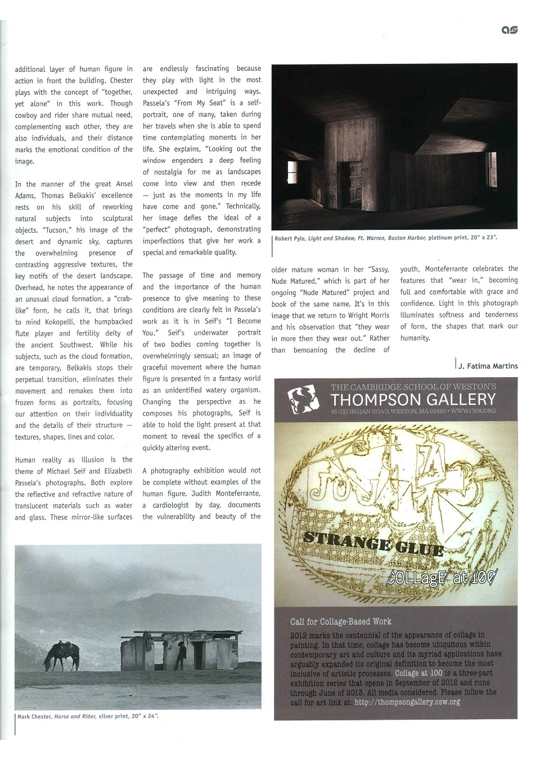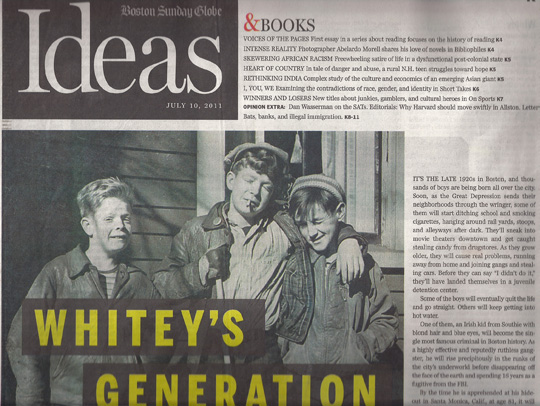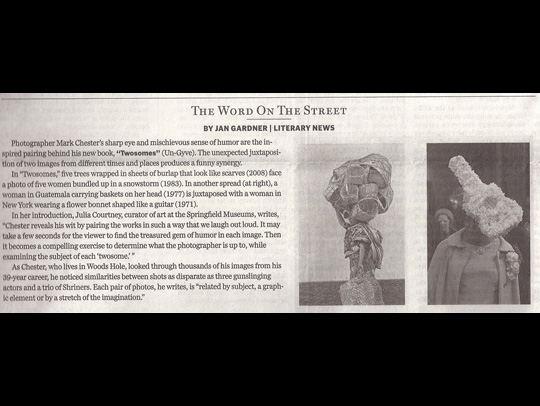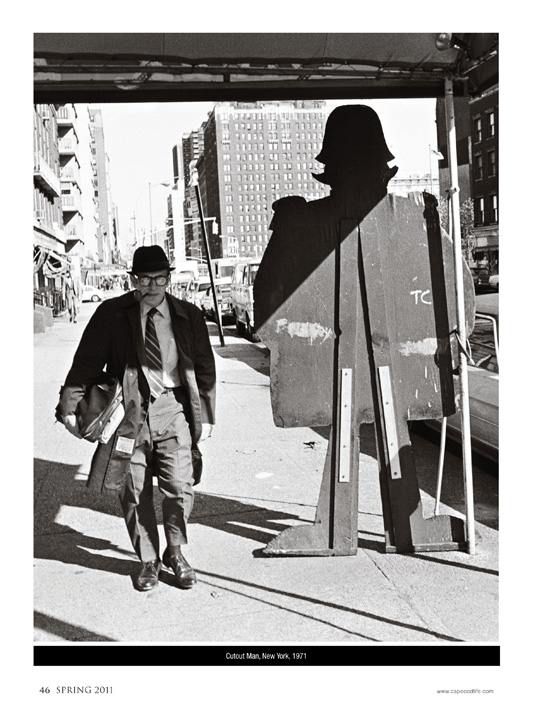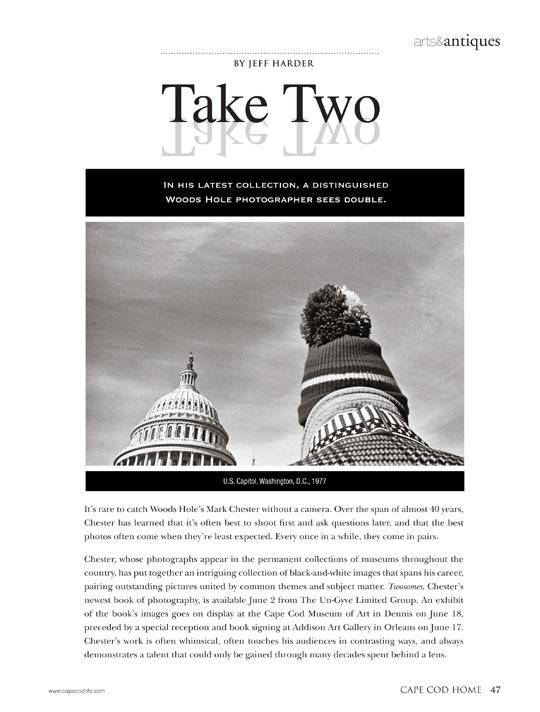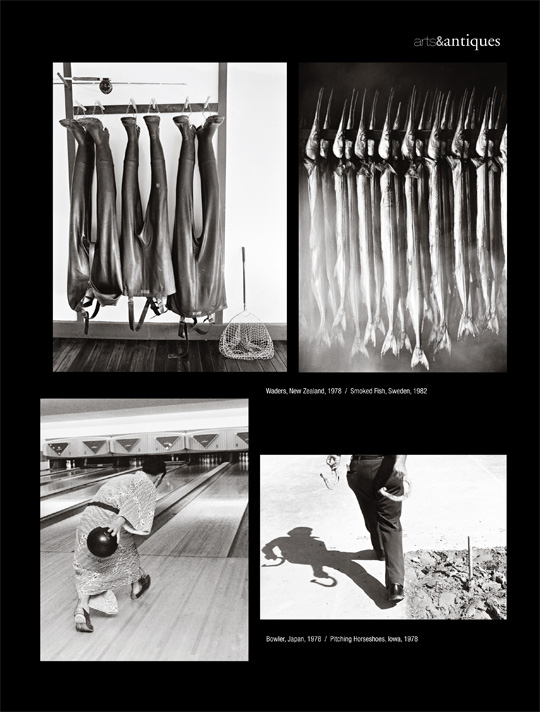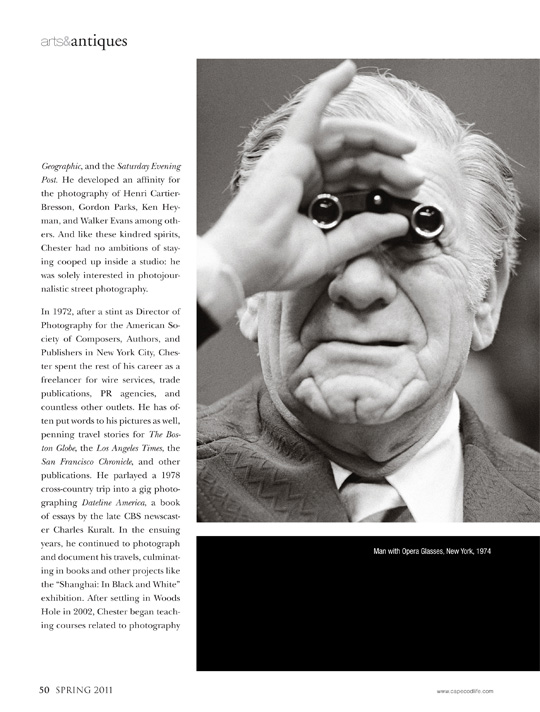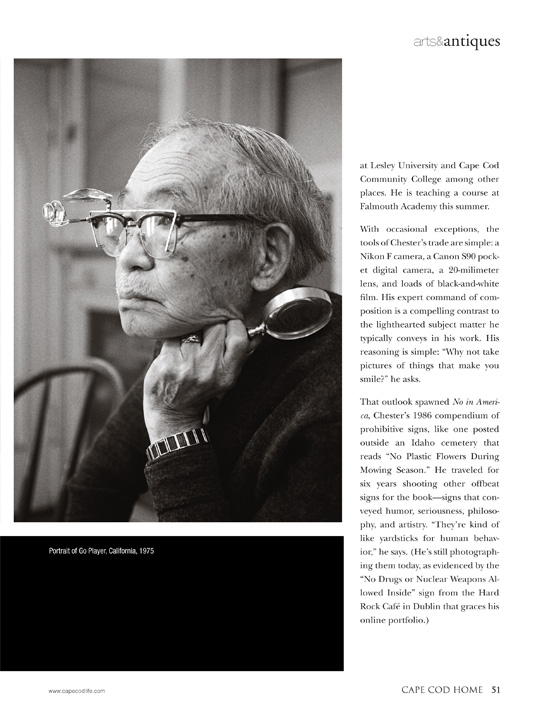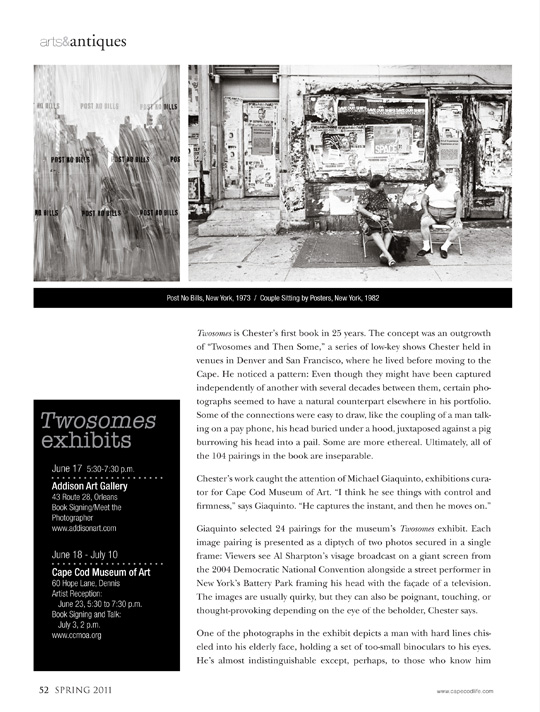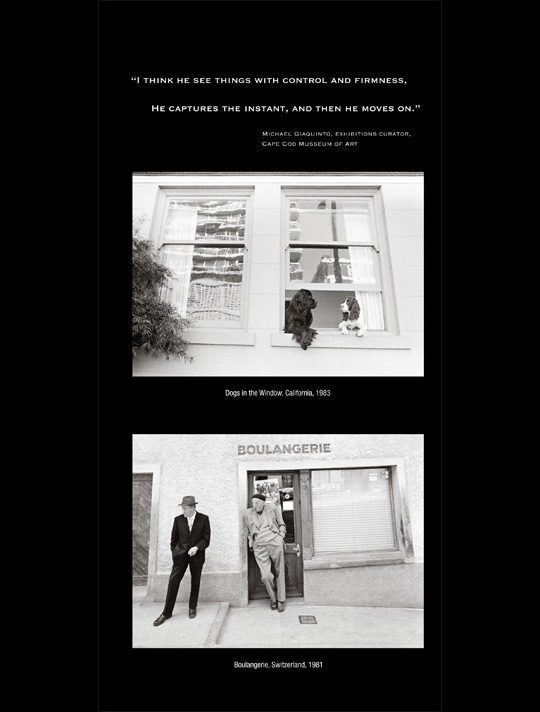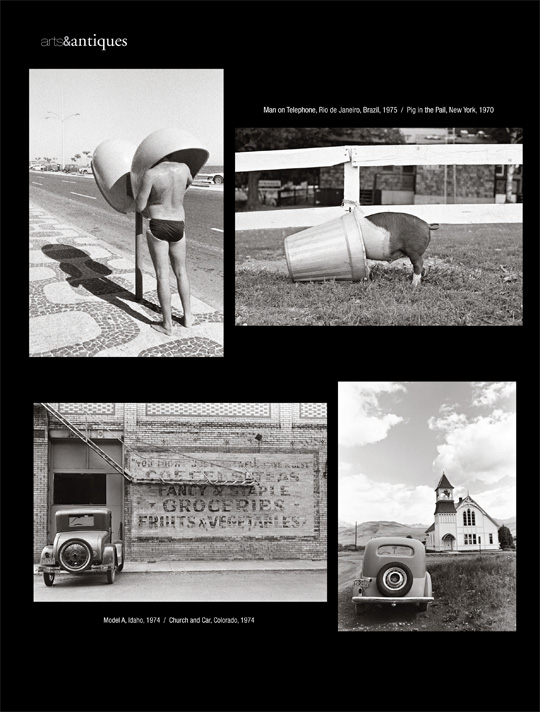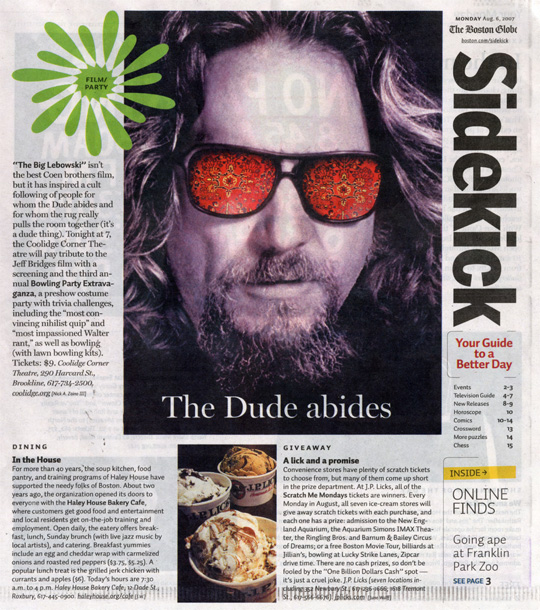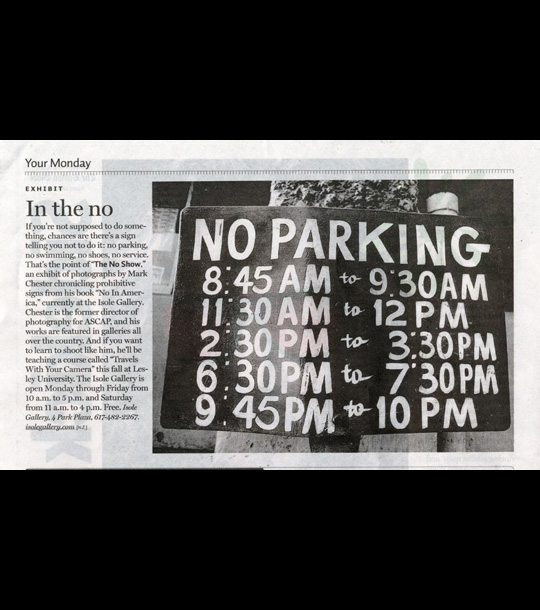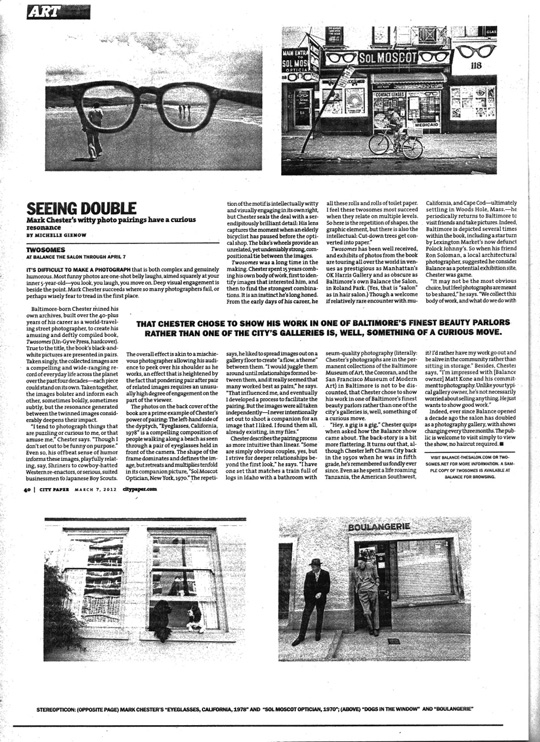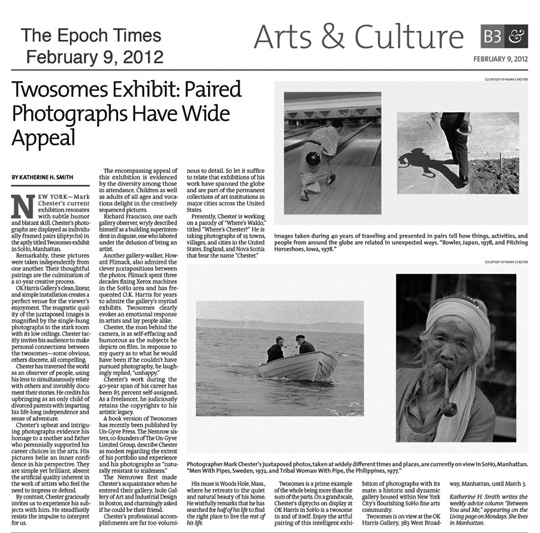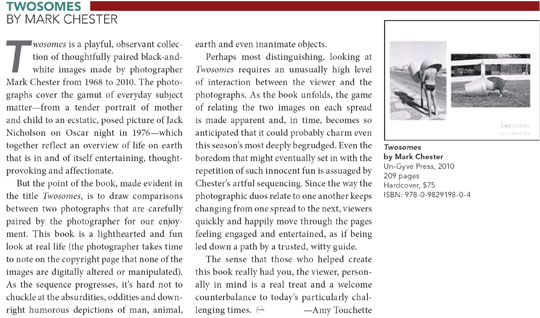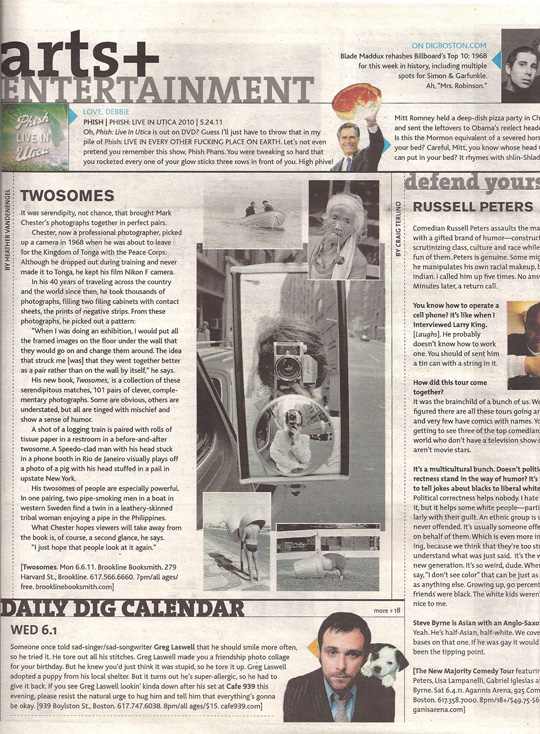IN PROFILE
"Photographs that simultaneously move you, make you think and make you laugh. How many photographers can do that? The answer is very, very few — and Mark Chester is one of them...."
Norman Ornstein
author, political scientist
Resident Fellow, American Enterprise Institute
TWOSOMES TAKES PDN PHOTO ANNUAL 2012 AWARD
“Thank you to all of the photographers who submitted work for the 2012 PDN Photo Annual. Congratulations to all of the photographers and creatives featured on the following pages. Every year we are amazed at the work we receive and it is an honor for us to reproduce the incredible work in this issue. The judges were faced with a difficult task in selecting this year’s winners."
PDN PHOTO ANNUAL 2012
Book Category winner Mark Chester: Twosomes (Un-Gyve Press)
MULTICULTURAL PHOTOS ON DISPLAY AT FALMOUTH ACADEMY
Cape News FALMOUTH ENTERPRISE September 20, 2019
‘“The Bay State: A Multicultural Landscape,” Mark Chester’s provocative black-and-white portrait series on the lives of new Americans living in Massachusetts, is on display at Falmouth Academy’s Driemeyer Gallery through October 15.
The show has been touring around the Bay State since 2015 with the aim of raising awareness, encouraging tolerance, celebrating diversity, and affirming the contributions of immigration to a healthy society. The show is winding down its tour in 2020 and will culminate with a book release thereafter.
Each individual portrait in the series was shot at a location chosen by the subject. The show is endorsed by the Massachusetts Immigrant and Refugee Advocacy Coalition.
Mark Chester was born in Baltimore, grew up in Springfield, Massachusetts, and now calls Cape Cod his home. He is a photojournalist, artist and author. He began photographing new Americans in 2011 to document the state’s diverse population and has photographed more than 400 participants representing 194 of the world’s 196 countries and territories.’
THE FALMOUTH ENTERPRISE: ARTS & ENTERTAINMENT
Mark Chester: The Bay State: A Multicultural Landscape.
PHOTOGRAPHY REVIEW
Questions of identity — public, personal, and beyond
Mark Feeney GLOBE STAFF MARCH 14, 2019
“Chester, whose father was born in what is now Belarus, has been photographing newly naturalized citizens throughout Massachusetts for the past three years. Working on the project, he’s met people from 160 countries — “traveling the world without leaving the state,” as he nicely puts it. Lest we forget, residents of Masschusetts don’t live in a state. They — we — live in a commonwealth. Chester’s photographs implicitly remind us of the human part of the wealth.”
BOSTON GLOBE: ART
Mark Chester: The Bay State: A Multicultural Landscape.
REVIEW: MASSACHUSETTS
The Bay State: A Multicultural Landscape—Photographs of New American
Stace Brandt ART NEW ENGLAND March/April 2019
“Chester, whose father was born in what is now Belarus, has been photographing newly naturalized citizens throughout Massachusetts for the past three years. Working on the project, he’s met people from 160 countries — “traveling the world without leaving the state,” as he nicely puts it. Lest we forget, residents of Masschusetts don’t live in a state. They — we — live in a commonwealth. Chester’s photographs implicitly remind us of the human part of the wealth.”
ART NEW ENGLAND: REVIEW
Mark Chester: The Bay State: A Multicultural Landscape—Photographs of New Americans at Brookline Arts Center, Boston City Hall Mayor’s Neighborhood Gallery, and Haverhill Public Library by Stace Brandt
SEEING DOUBLE
“Mark Chesterʼs witty photo pairings have a curious resonance.”
BALTIMORE CITY PAPER: ARTS FEATURE
Mark Chester: Twosomes (Un-Gyve Press)
PAIRED PHOTOGRAPHS HAVE A WIDE APPEAL
“His pictures belie an inner confidence in his perspective. They are simple yet brilliant, absent the artificial quality inherent in the work of artists who feel the need to impress or defend.
By contrast, Chester graciously invites us to experience his subjects with him. He steadfastly resists the impulse to interpret for us.”
THE EPOCH TIMES: ARTS & CULTURE FEATURE
Mark Chester: Twosomes (Un-Gyve Press) at OK HARRIS
TWOSOMES BY MARK CHESTER
“‘Twosomes’ is a playful, observant collection of thoughtfully paired black-and-white images .... it could probably charm even this season’s most deeply begrudged .... The sense that those who helped create this book really had you, the viewer, personally in mind is a real treat and a welcome counterbalance to today’s particularly challenging times.”
ASMP BULLETIN: YEAR END EDITION
Mark Chester: Twosomes (Un-Gyve Press)
THEN & NOW: THE ENDURING ALLURE OF LIGHT IN PHOTOGRAPY
"THE EXPLORATION OF HISTORY, the specifics of geography and atmosphere and the pull of travel are elements of Mark Chester's silver print 'Horse and Rider,' a highly layered and emotive photograph recently published in his new book Twosomes (Un-Gyve Press, Boston). Set atop and in foreground of an effective contrasting landscape, the image of a solitary cowboy and his horse projects a lonely slow experience. Here nostalgia speaks, memories are shifting and the objects of human life are slowly decaying. The visual focal point of Chester's image are the contrasting texture and hard lines of the abandoned building against the organic and smoky valley and mountain, with the additional layer of human figure in action in front of the building. Chester plays with the concept of "together, yet alone" in this work. Though [horse] and rider share mutual need, complementing each other, they are also individuals, and their distance marks the emotional condition of the image."
ARTSCOPE: FEATURE
Mark Chester: Twosomes (Un-Gyve Press) 'Horse & Rider' in THEN & NOW at the Copley Society of Art (CO|SO)
THE WORD ON THE STREET
"PHOTOGRAPHER MARK CHESTER'S SHARP EYE and mischievous sense of humor are the inspired pairing behind his new book, Twosomes (Un-Gyve). The unexpected juxtaposition of two images from different times and places produces a funny synergy.
In Twosomes, five trees wrapped in sheets of burlap that look like scarves (2008) face a photo of five women bundled up in a snowstorm (1983). In another spread (at right), a woman in Guatemala carrying baskets on her head (1977) is juxtaposed with a woman in New York wearing a flower bonnet shaped like a guitar (1971).
In her introduction, Julia Courtney, curator of art at the Springfield Museums, writes, 'Chester reveals his wit by pairing the works in such a way that we laugh out loud. It may take a few seconds for the viewer to find the treasured gem of humor in each image. Then it becomes a compelling exercise to determine what the photographer is up to, while examining the subject of each ‘twosome.’'
As Chester, who lives in Woods Hole, looked through thousands of his images from his 39-year career, he noticed similarities between shots as disparate as three gunslinging actors and a trio of Shriners. Each pair of photos, he writes, is “related by subject, a graphic element or by a stretch of the imagination.'
BOSTON GLOBE: BOOK REVIEW
Jan Gardner on Twosomes (Un-Gyve Press)
TWOSOMES
"IT WAS SERENDIPITY, not chance, that brought Mark Chester’s photographs together in perfect pairs.
Chester, now a professional photographer, picked up a camera in 1968 when he was about to leave for the Kingdom of Tonga with the Peace Corps. Although he dropped out during training and never made it to Tonga, he kept his film Nikon F camera.
In his 40 years of traveling across the country and the world since then, he took thousands of photographs, filling two filing cabinets with contact sheets, the prints of negative strips. From these photographs, he picked out a pattern:
'When I was doing an exhibition, I would put all the framed images on the floor under the wall that they would go on and change them around. The idea that struck me [was] that they went together better as a pair rather than on the wall by itself,' he says.
His new book, Twosomes, is a collection of these serendipitous matches, 101 pairs of clever, complementary photographs. Some are obvious, others are understated, but all are tinged with mischief and show a sense of humor.
A shot of a logging train is paired with rolls of tissue paper in a restroom in a before-and-after twosome. A Speedo-clad man with his head stuck in a phone booth in Rio de Janeiro visually plays off a photo of a pig with his head stuffed in a pail in upstate New York.
His twosomes of people are especially powerful. In one pairing, two pipe-smoking men in a boat in western Sweden find a twin in a leathery-skinned tribal woman enjoying a pipe in the Philippines.
What Chester hopes viewers will take away from the book is, of course, a second glance, he says.
'I just hope that people look at it again.'"
DIG BOSTON: BOOK REVIEW
Heather Vandenengel on Twosomes (Un-Gyve Press)
ARTS & ENTERTAINMENT
"LOCAL'S 40 YEARS OF PHOTOGRAPHY to Begin International Book Tour."
THE ENTERPRISE: BOOK REVIEW
Marilyn J. Rowland, Editor, on Twosomes (Un-Gyve Press)
TAKE TWO
"IT’S RARE TO CATCH Woods Hole’s Mark Chester without a camera. Over the span of almost 40 years, Chester has learned that it’s often best to shoot first and ask questions later, and that the best photos often come when they’re least expected. Every once in a while, they come in pairs.
Chester, whose photographs appear in the permanent collections of museums throughout the country, has put together an intriguing collection of black-and-white images that spans his career, pairing outstanding pictures united by common themes and subject matter. Twosomes, Chester’s newest book of photography, is available June 2 from The Un-Gyve Limited Group. An exhibit of the book’s images goes on display at the Cape Cod Museum of Art in Dennis on June 18, preceded by a special reception and book signing at Addison Art Gallery in Orleans on June 17. Chester’s work is often whimsical, often touches his audiences in contrasting ways, and always demonstrates a talent that could only be gained through many decades spent behind a lens.
In the living room of his Woods Hole home, Chester shuffles pages of proofs from the book across a coffee table. Many of the same images hang framed and matted in rows on the high walls around him. Chester—dressed in a plaid shirt and jeans, glasses perched on his nose—explains the origins of each photo and, in the process, traces the trajectory of his career.
As a kid in Springfield, Massachusetts, Chester took his first pictures with a Kodak Brownie camera. He didn’t get serious about photography until he joined the Peace Corps as a trainee in 1967 and bought professional camera set-up for his looming travels, which ultimately fell through. But he kept practicing his craft and studied the images in Life magazine, National Geographic, and the Saturday Evening Post. He developed an affinity for the photography of Henri Cartier-Bresson, Gordon Parks, Ken Heyman, and Walker Evans among others. And like these kindred spirits, Chester had no ambitions of staying cooped up inside a studio: he was solely interested in photojournalistic street photography.
In 1972, after a stint as Director of Photography for the American Society of Composers, Authors, and Publishers in New York City, Chester spent the rest of his career as a freelancer for wire services, trade publications, PR agencies, and countless other outlets. He has often put words to his pictures as well, penning travel stories for The Boston Globe, the Los Angeles Times, the San Francisco Chronicle, and other publications. He parlayed a 1978 cross-country trip into a gig photographing Dateline America, a book of essays by the late CBS newscaster Charles Kuralt. In the ensuing years, he continued to photograph and document his travels, culminating in books and other projects like the “Shanghai: In Black and White” exhibition. After settling in Woods Hole in 2002, Chester began teaching courses related to photography at Lesley University and Cape Cod Community College among other places. He is teaching a course at Falmouth Academy this summer.
With occasional exceptions, the tools of Chester’s trade are simple: a Nikon F camera, a Canon S90 pocket digital camera, a 20-milimeter lens, and loads of black-and-white film. His expert command of composition is a compelling contrast to the lighthearted subject matter he typically conveys in his work. His reasoning is simple: 'Why not take pictures of things that make you smile?' he asks.
That outlook spawned 'No in America', Chester’s 1986 compendium of prohibitive signs, like one posted outside an Idaho cemetery that reads 'No Plastic Flowers During Mowing Season.' He traveled for six years shooting other offbeat signs for the book—signs that conveyed humor, seriousness, philosophy, and artistry. 'They’re kind of like yardsticks for human behavior,' he says. (He’s still photographing them today, as evidenced by the 'No Drugs or Nuclear Weapons Allowed Inside' sign from the Hard Rock Café in Dublin that graces his online portfolio.)
TWOSOMES is Chester’s first book in 25 years. The concept was an outgrowth of “Twosomes and Then Some,” a series of low-key shows Chester held in venues in Denver and San Francisco, where he lived before moving to the Cape. He noticed a pattern: Even though they might have been captured independently of another with several decades between them, certain photographs seemed to have a natural counterpart elsewhere in his portfolio. Some of the connections were easy to draw, like the coupling of a man talking on a pay phone, his head buried under a hood, juxtaposed against a pig burrowing his head into a pail. Some are more ethereal. Ultimately, all of the 104 pairings in the book are inseparable.
Chester’s work caught the attention of Michael Giaquinto, exhibitions curator for Cape Cod Museum of Art. “I think he see things with control and firmness,” says Giaquinto. “He captures the instant, and then he moves on.”
Giaquinto selected 24 pairings for the museum’s Twosomes exhibit. Each image pairing is presented as a diptych of two photos secured in a single frame: Viewers see Al Sharpton’s visage broadcast on a giant screen from the 2004 Democratic National Convention alongside a street performer in New York’s Battery Park framing his head with the façade of a television. The images are usually quirky, but they can also be poignant, touching, or thought-provoking depending on the eye of the beholder, Chester says.
One of the photographs in the exhibit depicts a man with hard lines chiseled into his elderly face, holding a set of too-small binoculars to his eyes. He’s almost indistinguishable except, perhaps, to those who know him already. (In Twosomes, the image is presented alongside a photo of a man wearing several sets of eyeglasses, playing the ancient Asian board game Go.)
Chester noticed the man while shooting a Frank Sinatra concert on Long Island in 1974 for a wire service. 'Had I not turned around to see this guy,' Chester says, 'I would have missed him.' He licensed the image to a postcard publisher many years later. Some of the man’s children happened upon the postcard, and sought out a print from Chester to remember their father after his passing.
It was a scene captured in an instant that resonated for years after, and it was a scene that reflected one of Chester’s cardinal philosophies of photography. 'You take a photograph not because you know where to put it,' he says. 'You take it because it’s that moment.' Sometimes, those moments come in pairs.
Twosomes is an 11-by-13 hardcover book, totaling 218 pages with 202 plates. The book retails for $75. For more information, contact The Un-Gyve Limited Group at 617-350-7884, www.un-gyve.com, or log on to www.markchesterphotography.com."
CAPE COD HOME: FEATURE
Jeff Harder, Managing Editor, on Twosomes (Un-Gyve Press)
IN THE NO
"IF YOU'RE NOT SUPPOSED TO DO SOMETHING, chances are there's a sign telling you not to do it...."
BOSTON GLOBE: SIDE-KICK FEATURE
CLOSE-UP
"TWENTY YEARS AFTER Mark Chester's first photo exhibition in a New Jersey Playhouse, he still considers himself a new-comer in the fine art field ...."
PHOTOGRAPHER's MARKET: FEATURE
Profile: Mark Chester
A THOUSAND TIMES NO!
"WHEN MARK CHESTER WAS A HIGH SCHOOLER hanging out after classes at a pizza joint in Massachusetts 25 years ago, he spotted a sign one day, mispelled and taped above the jukebox. The message: 'NO DANCEING'...."
THE WASHINGTON POST: FEATURE
Don Oldenburg on No In America
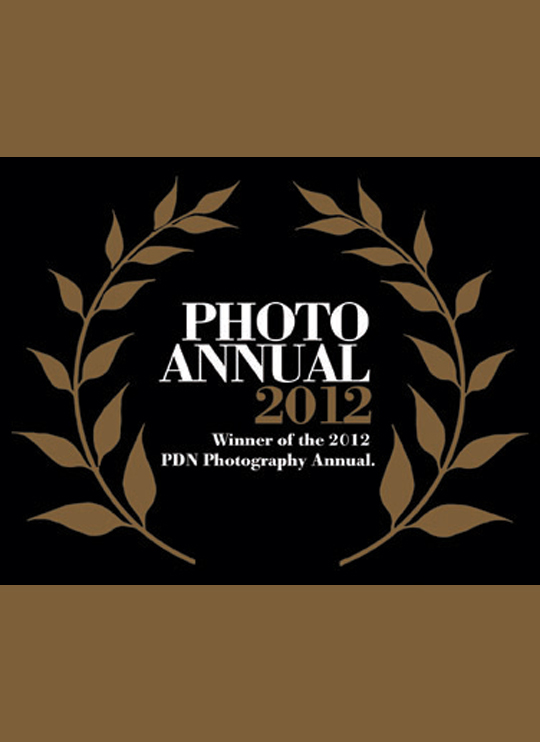
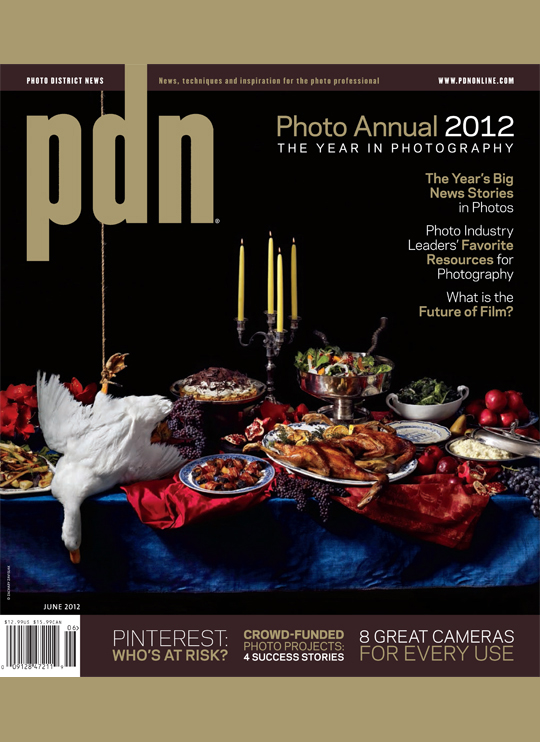
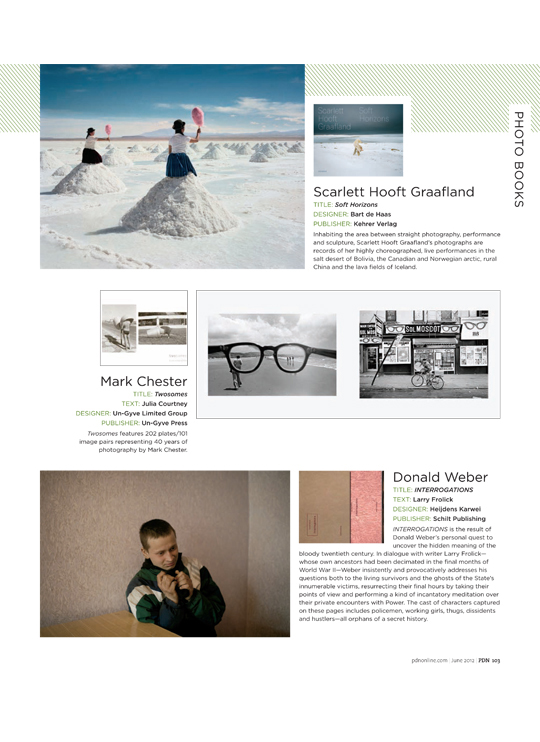
The Falmouth Enterprise Arts & Entertainment: Multicultural Photos on Display At Falmouth Academy Cape News FALMOUTH ENTERPRISE September 20, 2019. Photograph: Mark Chester’s “Mauritius: Jay”
Boston Globe Art: PHOTOGRAPHY REVIEW Questions of identity — public, personal, and beyond By Mark Feeney GLOBE STAFF MARCH 14, 2019. Photograph: Mark Chester’s “Ireland: Mary Walsh and Her Son, Marty, in His Office”
ART NEW ENGLAND: REVIEW Mark Chester: The Bay State: A Multicultural Landscape—Photographs of New Americans at Brookline Arts Center, Boston City Hall Mayor’s Neighborhood Gallery, and Haverhill Public Library by Stace Brandt


